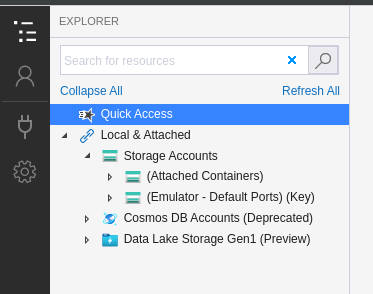

While we are in development, we want to use the emulator, and this requires a connection string. Step 4 – Set up a Development Connection String Once it starts up, a new icon appears in the system tray, giving you access to the UI, which shows you what ports it is running on:

To make life easy for me, I added an option to my External Tools list in Visual Studio so I could quickly launch it. It needs to be run with the /devstore comand line parameter: C:\Program Files\Microsoft SDKs\Windows Azure\Emulator\csrun.exe /devstore The emulator is csrun.exe and it took some tracking down as Microsoft seem to move it with every version of the SDK. It seems that with Azure web role projects, you can configure Visual Studio to auto-launch the Azure Storage emulator, but I don’t think that option is available for regular ASP.NET MVC projects hosted on Azure web sites. Step 3 – Setup the Azure Storage Emulator This is done using the Web Platform Installer. Each storage account can have many “containers” so you can share the same storage account between several sites if you want. This is quite straightforward in the Azure portal. So this is my guide to how I got it working with Azure web sites.

Azure blob storage is perfect for this, but I discovered that a lot of the tutorials assume you are using Azure “web roles” instead of Azure web sites, meaning that a lot of the instructions aren’t applicable. I wanted to allow website users to upload images, and store them in Azure. As someone who doesn’t usually do web development, there has been a lot of new stuff for me to learn. I have been building a website recently using Azure Web Site hosting and ASP.NET MVC 4.


 0 kommentar(er)
0 kommentar(er)
